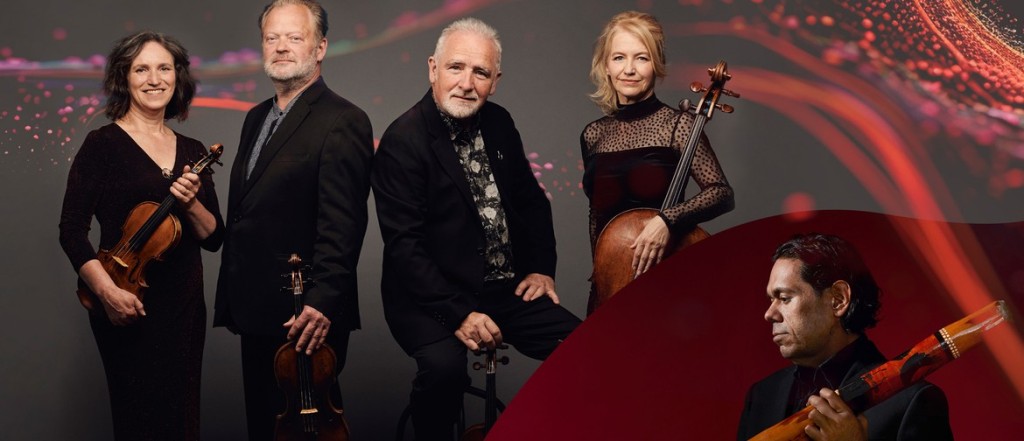Reviewed by John Daly-Peoples

Auckland Arts Festival
Barton and Brodsky
Auckland Concert Chamber
May 22
Reviewed by John Daly-Peoples
It seems misleading to describe the didgeridoo as a primitive instrument. The sounds it makes fit well within the scope of much contemporary music, there is complexity to their playing and they have an extraordinary musical history which parallels the history of many European instruments.
The instrument’s voice also seems to connect with the land and the history of the Aboriginal people with a deep spirituality .
The opening of the recent Barton and Brodsky concert heard that voice as the rumble of the didgeridoo welled up from the underworld to fill the Auckland Concert Chamber. This was didgeridoo of William Barton joining the string quarter for a remarkable concert of music, where the instrument contributed to several of the works.
Barton performed in Peter Sculthorpe’s “String Quartet No 11 “Jabiru Dreaming” which describes the Australian landscape and its animal life. His fitful and variable breathing gave a sense of the breath of life which giving soul to the land, and the sharp bursts of sound mapped out the patterns of landscape and geology. The strings contributed sharp shrill sounds of bird life and the murmurs of the bush.
In” Minjerribah” by Robert Davidson which paints a picture of the North Stradbroke Island Bartons didgeridoo again provided a sense of the timeless landscape while the strings created an almost romantic vision with evocative sounds of bird life, the shrill of cicadas, waves churning over beaches, deep blue skies and sun.
Barton also made a major contribution to the concert with his own composition “Square Circles beneath the Red Desert Sand” which he introduced walking from the rear of the hall channelling the spirits and the song lines of Australia, the sounds of his voice echoed by the strings. His singings took the form of a ritual, like the chants of many religions. Here along with the savage strings of the quartet, the sounds of the European instruments and didgeridoo showed the power of music to provide memory and narrative reaching across cultures.
Before the two works featuring the didgeridoo, the quartet played Henry Purcell’s early “Fantasia No 5 in D Minor” with all the elegance the work requires with Paul Cassidy’s viola adding a deep sonorous tone.
This finely crafted work was in marked contrast to the main work on the programme, “Janacek’s String Quartet No 11”. This work is subtitled “Intimate Letters” and is a musical representation of some 700 letters sent between Janáček and Kamila Stösslová which represented the composer’s intense emotions in that doomed relationship.
Passages of the work were played at not much more than a whisper which were then punctuated by dramatic piecing sounds from the strings as though representing the turmoil of the composer’s mind. In many of the sequences, violinist Krysia Ocostowicz led the group with her insistent playing and in the final movement played with a fevered urgency mirroring that of the composer.
The group also played Stravinsky’s “Three Pieces for String Quartet” which was written after his ballet music for Petrushka and owes much to folk music , the carnival and snippets recalling Latin chants.
They also played Salina Fisher’s “Torino – Echoes of the Putorino”. The putorino is a Māori instrument which can produce sounds as varied as a trumpet or a flute which the group were able to replicate. But while they were able to produce the sounds of the instrument, they were also imitating the sounds of the New Zealand bush and the native birds with the bright strings achieving the sound of several birds including the kiwi.
With Andrew Ford’s “String Quartet No 7: Eden Ablaze” which was a memorial and requiem to the Australian bush fires of 2019 / 20 the group captured the drama of the event, visions of the devastated landscape and the flight of the animals. There were surging sounds of the combined strings as well high-pitched sounds of distress while the didgeridoo provided a plaintive background.
To subscribe or follow New Zealand Arts Review site – www.nzartsreview.org.
The “Follow button” at the bottom right will appear and clicking on that button will allow you to follow that blog and all future posts will arrive on your email.
Or go to https://nzartsreview.org/blog/, Scroll down and click “Subscribe”
